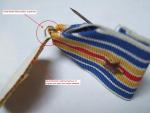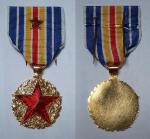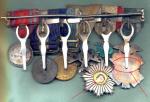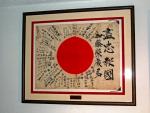
Tim B
Past Contributor-
Posts
2,234 -
Joined
-
Last visited
-
Days Won
2
Content Type
Profiles
Forums
Blogs
Gallery
Events
Store
Everything posted by Tim B
-
:whistle: Seller is mad that I returned the piece and left negative feedback on him (not his first btw). Can't imagine why I wasn't happy with him... Tim
-
Hi Beau! Yes, appears to be a nice original badge! Keep in mind that these continued to be made into the 30's, so we see a number of variations with hardware. I tend to think, with this style pin, that it might be a later made piece. With that said, there is some discoloration (due to heat?) on the reverse and perhaps the pin and/or hinge might have been repaired/replaced at one point. Do you see any indication of that in hand? Now, what I want to add is that the badge itself shows no die flaw like the one I pointed out on mine, and that tells me the piece is of the earliest strike, so that tends to lead me to a replaced pin, but I am not sure. Anybody else? One thing I still have questions on concerning these Schott marked badges; the reverse on originals always have these machine striations (scratches) on the surface and most examples I have seen are usually running in one direction, some go in various directions. Is there any rhyme or reason to what we should be seeing on these (orignals)? Nice looking badge and a nice addition to the thread! Tim
-
Another shot; Note the cheap suspension and how it wraps around the suspension ring. Also, the thickness of the medal is about 1/2 that of a normal wound medal when compared next to each other. Tim
-
Thought I would add a recent medal to the discussion here. After looking at all the various versions I found this one recently and feel it's a modern reproduction hitting the market. The seller used a photo of an orignal and then sent this one. Completely different from the version shown. I hate these guys that do that! Perhaps it's the current issue, but it is very cheaply made. Note the suspension shape, and though kind of close to an original style, this one is different. Perhaps someone more knowledgeable on current French issue medals can confirm that? The base metal on the medal itself is a cheap alloy or pot metal and not brass. The enamel is very thin, though it looks respectable. The gilding on this one appeared okay, but I have seen others that had small areas missing the gilding in the crevices. The small star has two bright brass pins and I suspect modern as well. I returned this one. Tim
-
2010 Silver Eagles Arrive Late
Tim B replied to bigjarofwasps's topic in Coins & Commemorative Medallions
Stopped in at a local coin show today and picked up a couple 2010's, as well as 2009's that I didn't get around to last year. Price is around $21./ea for the UNC coins. Considering spot silver is fluctuating around $17./ounce, I didn't think that was too bad for a minted coin. The dealer that I know stated he heard the mint was having some issues with the dies last couple of years and thinks that has added on the delay to get these out sooner. Tim -
American (US) Victory Medals
Tim B replied to Kev in Deva's topic in Inter-Allied Victory Medals of the Great War
Bosungus, If you don't want to lose money on worthless junk, avoid Charlie Snyder at all costs. If he lists anything original, it's marked up about 400% from other ebay listings. Search his name on just about any forum and you'll get the information you need to know. Be advised, he has others helping him move his junk on ebay as well. You usually find these sellers that mention they have "other militaria, including WWII German" that they need to sell, but can't list it on ebay. Anytime they offer to send you pictures or descriptions and list his site as a reference or where you can buy them--RUN! This isn't the clown where you got your .835 u-boat badge from, is it? Tim -
Hi Veteran! Actually, on the piece I have, Genie is only one possibilty I am looking into. The CdG is dated 1914-17, so if I am thinking correctly, it could be any of these units below: 1917 Croix de Guerre with Fourragere with the yellow and green colors of the ribbon of the Military decoration (Medaille de Militaire) for the units or regiments having four or five mentions in dispatches. Artillery: - 60th Field Artillery Regiment (30/12/1917) Engineers: - Company 15/12 Engineers of the 7th Regiment (09/08/1917) - Company 28/4 Engineers of the 28th Battalion (03/12/1917) Department of health: - Group stretcher-bearers of the 38th Infantry Division (30/11/1917) FOREIGN UNITS FOURRAGERE WITH THE TITLE OF THE WAR 1914-1918: - American medical section n° 646 [ex-S.S.U n° 5] (21/03/1919) ***not sure how to read this one*** - 15th Infantry Regiment of the Portuguese Army (04/04/1958). I assume the last two were late entitlements? Anyway, trying to find out some more on the history of the piece to eliminate some of the possibilities. Tim :beer:
-
Hi Don, Thanks for coming in. I tend to agree that the badge appears cast. The lines are rough looking and the details very soft IMO. The details should look much sharper, even if worn. With that last close-up of the pin, I like it and the catch even less. Almost looks like it has a base similar to what you would see on zinc items. Not sure if there is anything under the hinge. Gus? I am also looking at the reverse finish and ... is that spotting actually pitting on the surface? That would show evidence of casting. If it's the patina that makes it look this way, then I don't know, but if it's small pitting, that would seal my convictions on this being no good. Gus, There were other makers as you stated; Meybauer, Juncker, AWS, S&L to name the major ones that I know of, but your badge doesn't match any of them and as Don said, if a jeweler was contracted to produce one of these, first, he would not put the Schott mark on it and second, most jeweler pieces I have seen far exceed any mass produced pieces in quality. This one doesn't. Sorry, my vote is still negative here. Tim
-
Hi Gus, So, are you an actual Bosun (Warrant)? On the badge; yes, quite possible as so many post-war pieces were made to custom orders for those that wanted them. Silver versions would be completely unofficial though I believe? I do like the number's (font style) on the .935 and the patina looks somewhat period, but I would expect darker, almost black and not the brownish color. I am certainly no authority on those points and I know silver can be artificially toned, so.. I still question that pin and catch; that is the biggest concern I would have. As far as the die lines being completely different from the known, official, badges ... I can't say if it's a special run for silver issues, but I still have my doubts on originality. Perhaps more will comment on this now. Gordon Williamson would be a good source to ask if no one comments here. Best of luck on it! Tim
-
Okay, so we see a mark that is close to the known and accepted Schott mark; the "T" looks right, as does most of the "Schott" lettering, but the "Walter" lettering looks slightly off (may be the PIC?). Larger, sharper PIC's would help. The center part of "Walter" looks worn or weakly stamped. However, with all that said, the basic die characteristics of your badge are not the same as the originals I posted PIC's of earlier in the thread. - The crown is different in shape, including the cross style on the front of it. - The details of the boat are different, as is the basic outline of the boat itself; note how flat and narrow your boat is compared to all the others shown. - Wreath details are different. I'll stop there. Maybe someone else can give you a better opinion but, IMO, this is not an original Schott badge. Can't imagine why there would be such a completely different set of details even if making an after-market silver version, but...? Tim
-
Well, I have been hesitant to say anything here but, I honestly have major doubts on your badge. I can only assume by the lack of responses here, many others also have doubts on the originality of the badge you posted. I am not aware, personally, of any Imperial U-boat badge made in .935 silver, though I suppose an after-market, custom made, piece is possible. I do not like the pin or catch style on your badge and you would need to post much larger pictures to show the details and maker's (designer's) mark here. I suspect it will not match original Schott badges, but without better PIC's, cannot say for sure. Tim
-
Thanks Chris! I kind of suspected the "e" crossed over to "th" but wanted to confirm that. The Genie part makes sense as I seen one reference "sappers" but the translations kept coming back as "genius", so.. I have a 1917 CdG with mini fourragere in the colors of the Medaille Militaire and am trying to lock down the various units it could have came from. Thanks again! Tim :cheers:
-
Erik, It's a good thread to bring back up as not a lot of information exists on Japanese medal/ribbon bars. What is interesting to me, is that the photo shows the same arrangement as the medal bar posted (except the addition of the Showa Enthonement Medal to the bar) and it has the 1914-1920 campaign medal but not the WW1 Victory Medal. I was always under the impression that a bar would have both and not one without the other, but the Victory Medal wasn't authorized until 1920, so was the photo taken prior to that medal coming out? I have seen what appear to be genuine period bars with only the 1914-20 campaign medal on them before and often wonder about this point. The other point I have centers on the inconsistencies I see when mounting the Tashio Enthronement Medal; sometimes I see it before the WW1 medals and sometimes after. Not sure here as the enthronement medals would seem to be "lower" in precedence, but if mounted as they were earned, then the medal would come first as it was awarded in 1915. Lots of "little" questions. Tim
-
Here's a couple of general questions I had when researching CdG's and fourragere's. What is meant by the term "Genie"? Is it an HQ type command? 2nd question; when the units are referenced, as below, what is the meaning of the letter "e" behind the unit number? Génie : Compagnie 15/12 du 7e régiment de génie ( 09/08/1917 ) ; Compagnie 28/4 du 28e bataillon de génie ( 03/12/1917 ) ; Compagnie 6/3 et 6/53 du 9e régiment de génie ( 17/02/1919 ). Thanks! Tim
-
Hi Graham, The bar is simply tubular stock with ends that slip on (at least the ones I see). You can get these for a varied number of medals from one to ... max? I think you can still order these but don't quote me on that. Tim
-
Here's a link to some good information: http://www.france-phaleristique.com/ It may not answer your specific questions but, it has a wealth of information that may be of interest to you. Tim
-
Beautiful pieces! I can only imagine prices for those beauties, but you did quite well with those two! Tim
-
-
It's been several years since I used my Japanese while stationed in Yokosuka and today I couldn't tell you the differences between Kanji or Katakana. I knew some guys that took classes and were able to read and write Japanese. What I understand is that the characters in Chinese and Japanese are very similar and IF you can read one, you are pretty much able to figure the other one out. I do understand that translations are sometimes hard to figure 100% correctly, as the style is somewhat different "back then". Same can be said of German I guess when using terms from WWII. Also, as the Japanese were in China for so many years, many of the flags that have slogans from that area, are often slightly different than those elsewhere. The flag that I have, which belonged to a man from central Tokyo and fought (and died) in China, was translated originally as: 盡忠報國, read じんちゅうほうこく, more commonly written in Japanese as 尽忠報国, with the basic meaning of "loyalty to one’s country is rewarded". However, after another collector at WAF told me, the Japanese would never mention a "reward" for loyality or service to the country (and emperor), which makes total sense. So, Nick correctly translated the meaning to "Absolute Loyalty and Service to the Nation" which is more in line to what you would expect, and similar to the SS moto of "My Honor is Loyalty". Hope that helps a bit. I'll add a couple links that might help somewhat but, finding someone that can accuarately translate these flags is the better option IMO. http://hk.dictionary.yahoo.com/search.html?s=%BA%C9%A9%BE%B3%F8%B0%EA http://joechip.net/liana/archives/cat_japan.html http://www.gethistorytoday.com/ Tim :beer:
-
Hi Brian, Personally, I haven't seen too many medals (singles) that have damage indicative of this type of wear. I too have wondered, that over time, the medals would exhibit scratches or some type of groove pattern on the reverse; surprisingly, I haven't seen it. I do see the occasional Rising Sun or Sacred Treasure that have minor enamel damage towards the edges of the rays or paulina leaves that "might" be attributed to such wear. Usually some small chipping of the high points of the enamel tells me it was getting banged up by something else. The thing about Japanese ODM's, is that most are in near mint condition and even the ones mounted are in excellent condition, other than patina and sometimes soiled ribbons. You have to ask if they are in such pristine shape due to care of the owners/families, or if many are made up recently? There are many bars that have incorrect combinations and medal/ribbon bar references are not that plentiful. I also do not know just how often a member would be required to wear his "full dress" uniform and mounted medals. As a retired military guy, I rarely worn my medals for "full dress" occasions. So, other than official functions or Enthronement Ceremonies, just what a Japanese soldier/sailor would have worn them for...? Some interesting pieces though! Tim Thought I would add another PIC. You can see some scratching here on the Golden Kite (circled) and the center red enamel is missing on the Rising Sun. This is the most extensive "damage" that I have seen on the bars.
-
Tony, I wanted to add that it would be in your best interests to ask someone that can translate any of the Kanji on a flag you might be interested in. Also, the lettering on some of the fakes all have the same "type" brush strokes, so take your time and ask lots of questions on forums like this one prior to purchasing any flag. I got lucky and had some fellow collectors help me with mine. Based on the information I got from the seller and some collectors that can read these, I made a plate for mine. Not complete, but best I can do for now. Enjoy! Tim
-
But what about the tabs and strings in the corners? Is it unusual to find them with these and were the tabs leather? I see Tim's flag still has them attached. Could the red centre piece also be written on or was that frowned upon? Hi Tony, I'll let the PIC's do the talking. Tim
-
Some of these prayer flags were silk, others more of a silk/rayon material and the writing shows through as the material is quite translucent. I know cotton was used as well, though not sure if it was used on the prayer flags. Here's mine and the material is very fine (rayon/silk). I agree with Brian, the stains are most likely sweat stains from carrying them on the body or in the helmet. Tim









